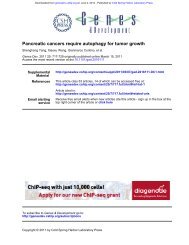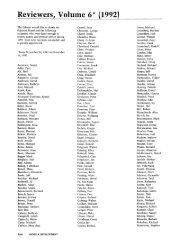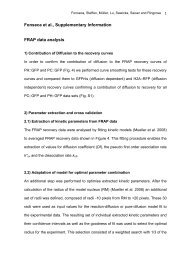I-Rel: a novel rei-related protein that inhibits NF-KB transcriptional ...
I-Rel: a novel rei-related protein that inhibits NF-KB transcriptional ...
I-Rel: a novel rei-related protein that inhibits NF-KB transcriptional ...
Create successful ePaper yourself
Turn your PDF publications into a flip-book with our unique Google optimized e-Paper software.
I-<strong>Rel</strong>: a <strong>novel</strong> <strong>rei</strong>-<strong>related</strong> <strong>protein</strong> <strong>that</strong><br />
<strong>inhibits</strong> <strong>NF</strong>-<strong>KB</strong> <strong>transcriptional</strong> activity<br />
Steven M. Ruben, John F. Klement, Timothy A. Coleman, Maureen Maher, Chein-Hwa Chen, and<br />
Craig A. Rosen^<br />
Department of Gene Regulation, Roche Institute of Molecular Biology, Nutley, New Jersey 07110 USA<br />
The <strong>NF</strong>-<strong>KB</strong> transcription factor complex is comprised of two subunits, p50 and p65, <strong>that</strong> share significant<br />
homology to the rel oncogene. We have isolated a cDNA encoding a <strong>novel</strong> 66-kD <strong>rei</strong>-<strong>related</strong> <strong>protein</strong>,<br />
designated I-<strong>Rel</strong>. Unlike other <strong>rei</strong>-<strong>related</strong> <strong>protein</strong>s, I-<strong>Rel</strong> does not interact with DNA. I-<strong>Rel</strong> forms<br />
heterodimers with p50, however, and greatly attenuates its DNA-binding activity—an effect probably resulting<br />
from the presence of a domain inhibitory to DNA binding present within the 121 amino-terminal residues of<br />
I-<strong>Rel</strong>. In contrast, I-<strong>Rel</strong> does not associate with p65. Transfection experiments demonstrate <strong>that</strong> I-<strong>Rel</strong><br />
suppresses <strong>NF</strong>-<strong>KB</strong>-induced transcription, probably through its association with p50. Expression of I-<strong>Rel</strong> mRNA<br />
is induced by mitogenic stimulation and accumulates after the appearance of p50 transcripts. Our findings<br />
suggest <strong>that</strong> p50 and I-<strong>Rel</strong> are components of a feedback pathway where expression of I-<strong>Rel</strong> may modulate<br />
indirectly the expression of genes responsive to the <strong>NF</strong>-<strong>KB</strong> transcription factor complex.<br />
[Key Words: <strong>NF</strong>-<strong>KB</strong>; transcription factor complex; rel oncogene]<br />
Received January 10, 1992; revised version accepted March 3, 1992.<br />
The <strong>NF</strong>-<strong>KB</strong> transcription factor complex, characterized<br />
originally as an immunoglobulin K light-chain enhancerbinding<br />
activity (Sen and Baltimore 1986a) is now known<br />
to be involved in the inducible expression of a large number<br />
of genes. Binding sites for <strong>NF</strong>-<strong>KB</strong> have been identified<br />
in the regulatory elements of cytokine, cytokine receptor,<br />
major histocompatability antigens, and several viral<br />
enhancer elements (for review, see Lenardo and Baltimore<br />
1989; Gilmore 1990; Baeuerle and Baltimore 1991).<br />
<strong>NF</strong>-<strong>KB</strong> is composed of a 50-kD and a 65-kD <strong>protein</strong> subunit<br />
(Baeuerle and Baltimore 1989; Ghosh and Baltimore<br />
1990). Identification and cloning of the individual genes<br />
encoding <strong>protein</strong>s <strong>that</strong> comprise the <strong>NF</strong>-<strong>KB</strong> transcription<br />
factor complex permit insight into this important signal<br />
transduction pathway. For example, it is known <strong>that</strong> residues<br />
present within the amino terminus of both the p50<br />
(Bours et al. 1990; Ghosh et al. 1990; Kieran et al. 1990)<br />
and the p65 (Nolan et al. 1991; Ruben et al. 1991) subunits<br />
of <strong>NF</strong>-<strong>KB</strong> share considerable homology with the<br />
oncogene c-<strong>rei</strong>, as does the amino terminus of the Diosophila<br />
maternal morphogcn dorsal (Steward 1987). The<br />
Y-rel oncogene, identified originally in the avian reticulocndotheliosis<br />
retrovirus Rev T (Theilen et al. 1966),<br />
causes lymphoid cell tumors in birds (for review, see<br />
Rice and Gilden 1988). It is now clear <strong>that</strong> the rel family<br />
of <strong>protein</strong>s possesses <strong>transcriptional</strong> regulatory properties<br />
(Gelinas and Temin 1988; Hannink and Temin<br />
1989; Rushlow ct al. 1989; Bull et al. 1990; Kamens et al.<br />
1990; Richardson and Gilmore 1991; Urban et al. 1991).<br />
'Corresponding author.<br />
Downloaded from<br />
genesdev.cshlp.org on December 18, 2012 - Published by Cold Spring Harbor Laboratory Press<br />
Residues within the rel homology region confer the ability<br />
to form homomeric and heteromeric <strong>protein</strong> complexes,<br />
a process prerequisite for DNA binding (Ballard et<br />
al. 1990; Ghosh et al. 1990; Kieran et al. 1990; Ruben et<br />
al. 1992). After association with DNA, certain combinations<br />
of these <strong>protein</strong>s elicit <strong>transcriptional</strong> activation,<br />
the best example being the association of p50 and p65 in<br />
<strong>NF</strong>-<strong>KB</strong> (Kawakimi et al. 1988; Schmitz and Baeuerle<br />
1991; Ruben et al. 1992). Other associations may serve<br />
different functions, as the association of v-rel with <strong>NF</strong>-<br />
<strong>KB</strong> has been shown to suppress <strong>transcriptional</strong> activation<br />
(Ballard et al. 1990).<br />
Earlier studies demonstrated <strong>that</strong> the entire <strong>NF</strong>-<strong>KB</strong> signal<br />
transduction pathway is under stringent regulatory<br />
control. In resting cells, the p50-p65 complex exists in<br />
the cytoplasm in an inactive state bound with the repressor<br />
<strong>protein</strong> I<strong>KB</strong> (Baeuerle and Baltimore 1988a,b) by<br />
interaction with the p65 subunit (Baeuerle and Baltimore<br />
1989; Urban and Baeuerle 1990). The property of regulation<br />
by subcellular localization is shared by each of the<br />
<strong>rei</strong>-<strong>related</strong> family members. For example, the chicken<br />
c-<strong>rei</strong> <strong>protein</strong> is localized in the cytoplasm of avian fibroblasts,<br />
whereas the Y-iel <strong>protein</strong> is nuclear in these cells<br />
(Capobianco et al. 1990). In transformed avian lymphoid<br />
cells, however, y-rel is localized primarily in the cytoplasm<br />
(Gilmore and Temin 1986). In addition, the pp40<br />
phospho<strong>protein</strong>, which is identical to I-<strong>KB</strong> |3 (Zabel and<br />
Baeuerle 1990), prevents DNA binding of both c-<strong>rei</strong> and<br />
<strong>NF</strong>-<strong>KB</strong> by maintaining a cytoplasmic pool of these <strong>protein</strong>s<br />
(Davis et al. 1991; Kerr et al. 1991). Similarly, the<br />
Drosophila maternal morphogen dorsal is localized in<br />
GENES & DEVELOPMENT 6:745-760 © 1992 by Cold Spring Harbor Laboratory Press ISSN 0890-9369/92 $3.00 745







